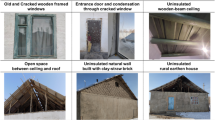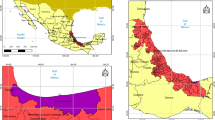Abstract
Humidity of indoor air is an important factor influencing the air quality and energy consumption of buildings as well as durability of building components. Indoor humidity depends on several factors, such as moisture sources, air change, sorption in materials and possible condensation. Since all these phenomena are strongly dependent on each other, numerical predictions of indoor humidity need to be integrated into combined heat and airflow simulation tools. The purpose of a recent international collaborative project, IEA ECBCS Annex 41, has been to advance development in modelling the integral heat, air and moisture transfer processes that take place in “whole buildings” by considering all relevant parts of its constituents. It is believed that full understanding of these processes for the whole building is absolutely crucial for future energy optimization of buildings, as this cannot take place without a coherent and complete description of all hygrothermal processes. This paper will illustrate some of the modelling work that has taken place within the project and present some of the simulation tools used.
Similar content being viewed by others
References
Barbosa R M, Mendes N (2007). Combined simulation of central HVAC systems with a whole-building hygrothermal model. Energy and Buildings.(In press).
Bonneau D, Rongere FX, Covalet D, Gauthier B (1993). Clim2000: modular software for energy simulation in buildings. In: Proceedings of IBPSA 93, Adelaïde, Australia.
Clarke JA (1985). Energy simulation in building design. Bristol and Boston: Adam Hilger.
Crawley DB, Lawrie LK, Pedersen CO, Winkelmann FC (2004). EnergyPlus: an update. In: Proceedings of SimBuild 2004, Building Sustainability and Performance Through Simulation, Boulder, CO, USA, Aug. 2004.
Crawley DB, Hand JW, Kummert M, Griffith BT (2005). Contrasting the capabilities of building energy performance simulation programs. In: Proceeding of the Ninth International IBPSA Conference, Montreal, Canada, Aug. 2005.
Duforestel T, Dalicieux P (1994). A model of hygroscopic buffer to simulate the indoor air humidity behaviour in transient conditions. In: Proceedings of European Conference on Energy Performance and Indoor Climate in buildings, Lyon, France. Vol 3, pp. 791–797.
Grunewald J (2000). Documentation of the numerical simulation program DIM3.1, Vol 1: Theoretical fundamentals. Delphin4 program installation available on the ftp-server of the Institute of Building Climatology http://bauklimatik-dresden.de/software.html.
Häupl P, Fechner H, Petzold H (2004). Interior retrofit of a masonry wall to reduce energy and eliminate moisture damages: comparison of modelling and field performance. In: Proceedings of Buildings IX Conference, Clearwater Beach, FL, USA.
Henninger RH, Witte MJ, Crawley DB (2004). Analytical and comparative testing of energyPlus using IEA HVAC BESTEST E100-E200 test suite. Energy and Buildings, 36(8): 855–863.
Hens H (2002). Heat, air and moisture transport in highly insulated building envelopes (HAMTIE). Technical Synthesis Report IEA ECBCS Annex 24. UK, FaberMaunsell Ltd.
Holm A, Künzel HM, Sedlbauer K (2003). The hygrothermal behaviour of rooms: combining thermal building simulation and hygrothermal envelope calculation. In: Proceedings of 8th International IBPSA Conference, Eindhoven, Netherlands.
Holm A, Lengsfeld K (2007). Moisture-buffering effect—experimental investigations and validation. In: Proceedings Buildings X Conference, Thermal Performance of the Exterior Envelopes of Whole Buildings, Clearwater Bach, FL, USA.
Hong SH, Ridley I, Oreszczyn T (2003). A hygrothermal monitoring and modelling of a historic roof. In: Proceedings 8th International IBPSA Conference, Eindhoven, Netherlands, Vol 1, pp. 515–522.
Iwamae A, Hanibuchi H, Chikada T (1999). A windows-based PC-software to design thermal environment in residential houses. In: Proceedings of Building Simulation’99, Vol 3, pp. 1325–1330.
Iwamae A (2004). A development of PC software to calculate temperature and humidity variations in residential houses. Publication A41-T1-J-04-1. Presentation for IEA Annex 41 meeting, Glasgow, UK, Oct. 2004.
Judkoff R, Neymark J (1995). Building energy simulation test (BESTEST) and diagnostic method. NREL/TP-472-6231. Golden, Colo.: National Renewable Energy Laboratory, USA.
Kalamees T (2004). IDA ICE: the simulation tool for making the whole building energy and HAM analysis. Publication A41-T1-EE-04-1. Presentation for IEA Annex 41 meeting, Zurich, Switzerland, May 2004.
Klein SA, Beckman WA, Mitchell JW, Duffie JA, et al. (2004). TRNSYS 16—a TRaNsient SYstem Simulation program, User manual. Solar Energy Laboratory. Madison: University of Wisconsin-Madison, USA.
Koronthályová O (1997). The effect of the inner surface material on the indoor relative humidity. In: Proceedings of International Thermal Energy and Environment Congress (ITEEC 97), Ecole Superieure de Technologie Agadir, Vol 2, pp. 557–561.
Koronthályová, O (1998). Non-steady model for calculation of indoor air relative humidity. Building Research Journal, 46: 201–211.
Koronthályová O, Mihálka P, Matiašovský P (2004). Model for complex simulation of HAM-transfer in a single thermal zone building. Building Research Journal, 2004, 52(4): 199–217.
Künzel HM (1994). Simultaneous heat and moisture transport in building components. Dissertation. University of Stuttgart, Stuttgart, available via http://www.building-physics.com.
Kurnitski J, Vuolle M (2000). Simultaneous calculation of heat, moisture, and air transport in a modular simulation environment. In: Proceedings of the Estonian Academy of Sciences Engineering, Mar. 2000, Vol. 6/1, pp. 25–47.
Lenz K (2006). CE3—Two real exposure rooms at FhG. Results of the complete Common Exercise 3. Publication A41-T1-D-06-1. Presentation for IEA Annex 41 meeting, Kyoto, Japan, Apr. 2006.
Lomas KJ et al. (1997). Empirical validation of building energy simulation programs. Energy and Buildings, 26: 253–275.
Mendes N, Philippi PC, Lamberts R (2002). A new mathematical method to solve highly coupled equations of heat and mass transfer in porous media. International Journal of Heat and Mass Transfer, 45: 509–518.
Mendes N, Oliveira RCLF, dos Santos GH (2003). Domus 2.0: a whole-building hygrothermal simulation program. In: Proceedings of 8th International IBPSA Conference, Eindhoven, Netherlands.
Mendes N, Philippi PC (2005). A method for predicting heat and moisture transfer through multilayered walls based on temperature and moisture content gradients. International Journal of Heat and Mass Transfer, 48: 37–51.
Mendonça KC, Wurtz E, Inard C (2005). Predicting temperature and moisture distribution in conditioned spaces using the zonal approach. In: Proceedings of International IBPSA Conference, Montréal, Canada, pp. 763–768.
Mora L, Wurtz E, Mendonça KC, Inard C (2004). Effects of coupled heat and moisture transfers through walls upon indoor environment predictions. International Journal of Ventilation, 3(3): 227–234.
Perschk A, Meinhold U (2007). Ein Modell zur hygrisch-thermischen Gebäudesimulation mit Hilfe der Kopplung von Zonen-und Feldmodell. Bauphysik, 29(1): 55–62. (in German).
Plathner P, Woloszyn M (2002). Interzonal air and moisture transport in a test house: experiment and modelling. Building and Environnement, 37(2): 189–199.
Rode C, Grau K (2003). Whole building hygrothermal simulation model. ASHRAE Transactions, 109(1): 572–582.
Rode C, Grau K (2004). Calculation tool for whole building hygrothermal analysis building simulation 2000. Publication A41-T1-DK-04-1. Presentation for IEA Annex 41 meeting, Zurich, Switzerland, May 2004.
Rode C, Peuhkuri R, Woloszyn M (2006). Simulation tests in whole building heat and moisture transfer. Paper presented at International Building Physics Conference, Montreal, Canada, Aug. 2006.
Sahlin P, Eriksson L, Grozman P, Johnsson H, Shapovalov A, Vuolle M (2004). Whole-building simulation with symbolic DAE equations and general purpose solvers. Building and Environment, 39(8): 949–958.
Sasic Kalagasidis A (2004). HAM-Tools: an integrated simulation tool for heat, air and moisture transfer analyses in building physics. PhD Dissertation. Chalmers University of Technology, Gothenburg, Sweden.
Sasic Kalagasidis A, Weitzmann P, Nielsen TR, Peuhkuri R, Hagentoft C-E, Rode C (2007). The international building physics toolbox in Simulink. Energy and Buildings, 39(6):665–674.
van Schijndel AWM (2007). Integrated heat, air & moisture modelling and simulation. PhD Dissertation. Eindhoven University of Technology.
Sofic M, Bednar T (2007). Analyses of the accuracy of monthly energy balances for assessment of cooling energy demand (Analyse Der Genauigkeit Des Monatsbilanzverfahrens Zur Ermittlung Des Kühlbedarfs Von Nichtwohngebäuden). Bauphysik, 29(3): 202–207. (in German).
Tariku F, Kumaran MK, Fazio P (2006). Whole building heat and moisture analysis. Publication A41-T1-C-06-8. Presentation for IEA Annex 41 meeting, Lyon, France, Oct. 2006.
de Wit MH (2006). Hambase: heat, air and moisture model for building and systems evaluation. Eindhoven, Netherlands: Eindhoven University Press.
Woloszyn M, Rusaouen G, Covalet D (2004). Whole building simulation tools: Clim2000. Publication A41-T1-F-04-3. Presentation for IEA Annex 41 meeting, Zurich, Switzerland, May 2004.
Woloszyn M, Rode C (2007). Annex 41, Subtask 1: Modelling principles and common exercises. Draft Final Report for the Energy Conservation in Buildings and Community Systems executive committee of the International Energy Agency.
Wurtz E, Haghighat F, Mora L, Mendonca KC, Maalouf C, Zhao H, Bourdoukan P (2006). An integrated zonal model to predict transient indoor humidity distribution. ASHRAE Transactions, (112)2: 175–186.
Author information
Authors and Affiliations
Corresponding author
Rights and permissions
About this article
Cite this article
Woloszyn, M., Rode, C. Tools for performance simulation of heat, air and moisture conditions of whole buildings. Build. Simul. 1, 5–24 (2008). https://doi.org/10.1007/s12273-008-8106-z
Received:
Revised:
Accepted:
Issue Date:
DOI: https://doi.org/10.1007/s12273-008-8106-z




